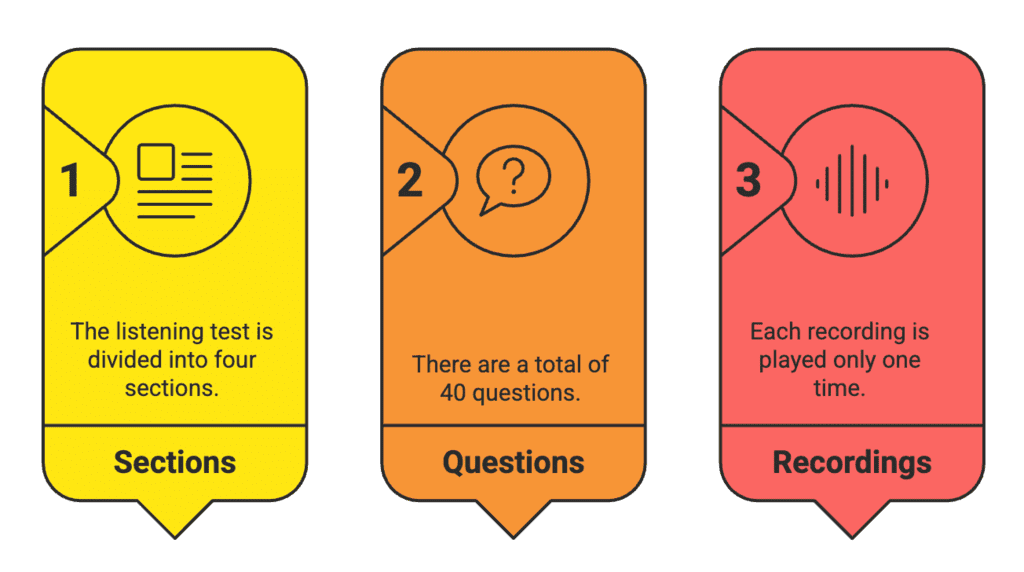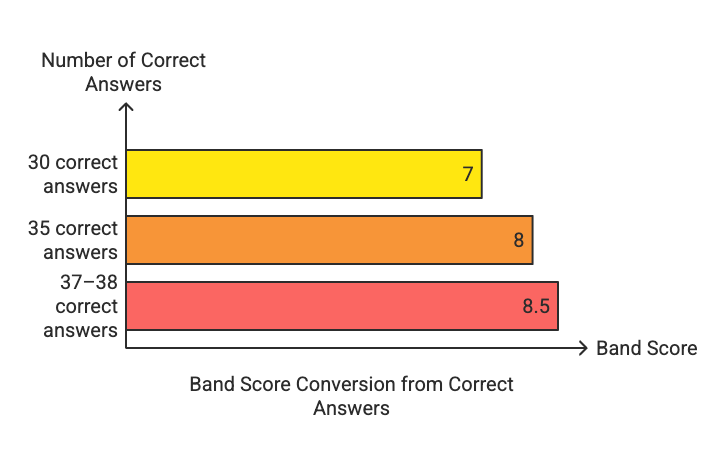Top FAQs: IELTS Listening Test | Listening for IELTS PDF Download
The IELTS Listening Test assesses your ability to understand spoken English in everyday and academic contexts. It is the same for both Academic and General Training candidates. Below are the 15 most frequently asked questions to help you prepare effectively and feel confident on test day.
1. What is the format of the IELTS Listening Test?
The Listening test consists of 4 sections with 40 questions in total. You will hear 4 recordings, each played once only, and answer questions based on what you hear.

2. How long is the Listening Test?
- The test takes approximately 30 minutes.
- If you're taking the paper-based test, you'll get an extra 10 minutes to transfer your answers to the answer sheet.
- In the computer-based test, you get 2 minutes to review your answers.
3. Is the Listening test the same for Academic and General Training?
Yes. The Listening section is identical for both versions of the IELTS exam. Everyone takes the same test.
4. What are the 4 sections about?
Section 1 – A conversation in a social context (e.g., booking a hotel room)
Section 2 – A monologue in a social context (e.g., a guided tour)
Section 3 – A conversation in an academic context (e.g., a discussion between students)
Section 4 – A lecture or talk on an academic subject
5. What kinds of questions are asked?
You may encounter:
Multiple choice
Matching
Sentence completion
Form/table/flow-chart/note completion
Map or diagram labelling
Short-answer questions
6. Can I take notes during the Listening Test?
Yes. You are encouraged to take notes or underline keywords. For paper-based tests, you can write directly on the question paper. In computer-based tests, on-screen highlighting tools are available.
7. Will I hear each recording more than once?
No. Each recording is played only once, so it is important to stay focused and follow along as you listen.
8. Can I listen and read the questions at the same time?
Yes. Before each section starts, you are given time to read the questions. Use this time wisely to predict information and identify keywords.
9. Do I lose marks for incorrect answers?
No. There is no negative marking, so always attempt every question, even if you're unsure.
10. Is spelling important in the Listening Test?
Yes. Incorrect spelling or grammar will result in a wrong answer. Make sure to check your spelling carefully, especially for common words and names.
11. Should I write in uppercase or lowercase letters?
You can write in ALL CAPITAL LETTERS or lowercase, but be consistent throughout your answer sheet. Many candidates choose all capitals for clarity.
12. What accents will I hear?
The recordings include a variety of English accents, such as British, American, Australian, Canadian, and New Zealand. This tests your ability to understand English as it is spoken globally.
13. How is the Listening Test scored?
Each correct answer earns 1 mark, and your raw score (out of 40) is converted to a band score (0–9).
Example Band Score Conversion:
30 correct answers ≈ Band 7
35 correct answers ≈ Band 8
37–38 correct answers ≈ Band 8.5

14. Can I change my answers while listening?
You can revise your answers during the breaks between sections. In the paper test, use the 10-minute transfer time wisely. In the computer test, use the final 2-minute review period.
15. How can I improve my IELTS Listening skills?
Practice with authentic IELTS Listening tests
Get used to different English accents
Work on predicting answers based on the question
Practice listening for specific details and main ideas
Focus on spelling, numbers, and common formats (e.g., dates, phone numbers)
|
70 videos|39 docs
|
FAQs on Top FAQs: IELTS Listening Test - Listening for IELTS
| 1. What is the format of the IELTS Speaking Test? |  |
| 2. How long does the IELTS Speaking Test take? |  |
| 3. What types of questions can I expect in the IELTS Speaking Test? |  |
| 4. Do I need to prepare specific topics for the IELTS Speaking Test? |  |
| 5. How is the IELTS Speaking Test scored? |  |
















